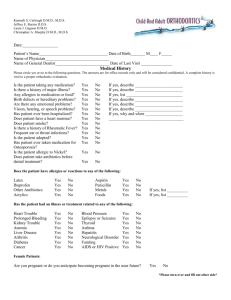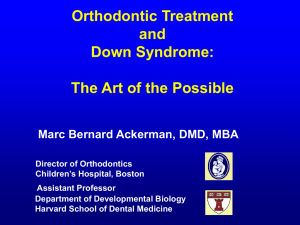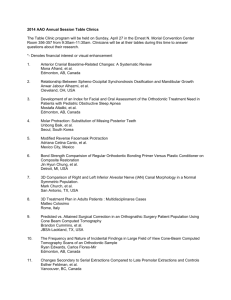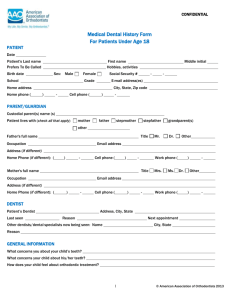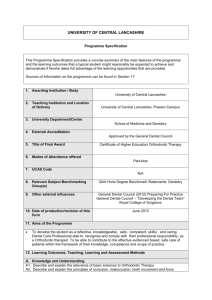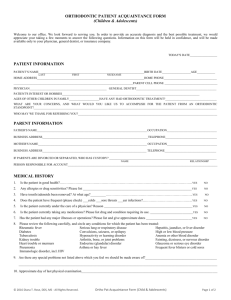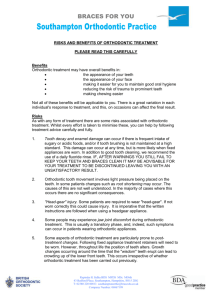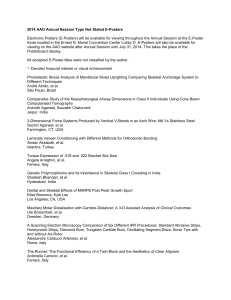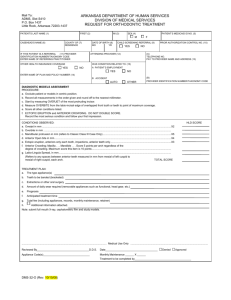Charley Schultz Resident Scholar Award Participants Listing_2014
advertisement
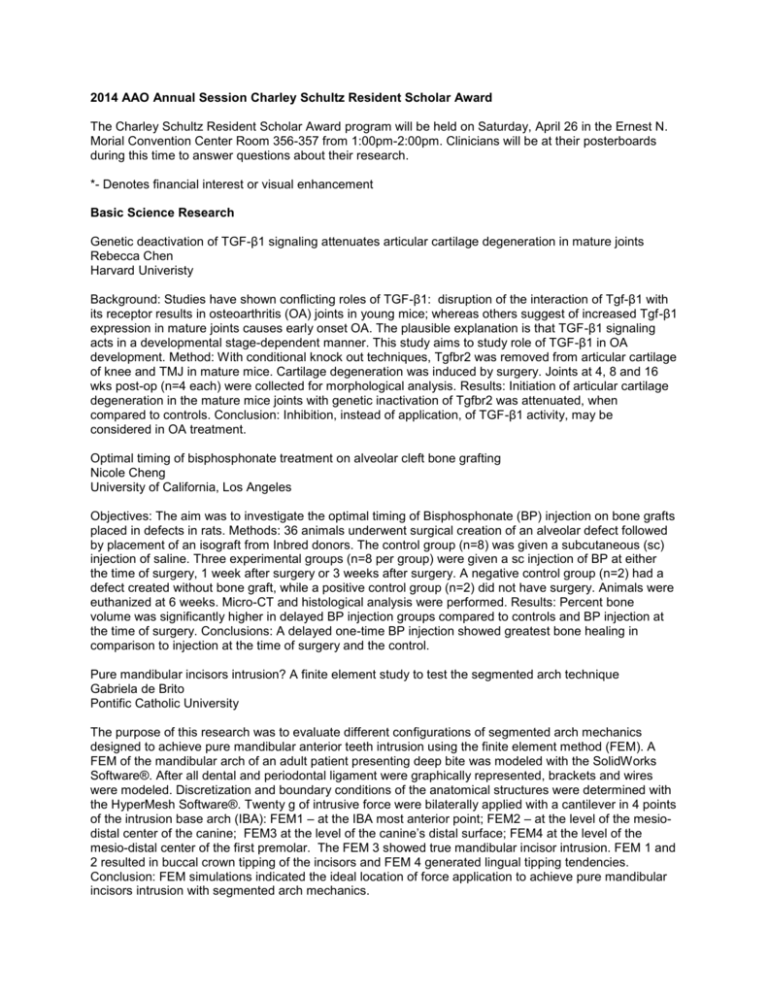
2014 AAO Annual Session Charley Schultz Resident Scholar Award The Charley Schultz Resident Scholar Award program will be held on Saturday, April 26 in the Ernest N. Morial Convention Center Room 356-357 from 1:00pm-2:00pm. Clinicians will be at their posterboards during this time to answer questions about their research. *- Denotes financial interest or visual enhancement Basic Science Research Genetic deactivation of TGF-β1 signaling attenuates articular cartilage degeneration in mature joints Rebecca Chen Harvard Univeristy Background: Studies have shown conflicting roles of TGF-β1: disruption of the interaction of Tgf-β1 with its receptor results in osteoarthritis (OA) joints in young mice; whereas others suggest of increased Tgf-β1 expression in mature joints causes early onset OA. The plausible explanation is that TGF-β1 signaling acts in a developmental stage-dependent manner. This study aims to study role of TGF-β1 in OA development. Method: With conditional knock out techniques, Tgfbr2 was removed from articular cartilage of knee and TMJ in mature mice. Cartilage degeneration was induced by surgery. Joints at 4, 8 and 16 wks post-op (n=4 each) were collected for morphological analysis. Results: Initiation of articular cartilage degeneration in the mature mice joints with genetic inactivation of Tgfbr2 was attenuated, when compared to controls. Conclusion: Inhibition, instead of application, of TGF-β1 activity, may be considered in OA treatment. Optimal timing of bisphosphonate treatment on alveolar cleft bone grafting Nicole Cheng University of California, Los Angeles Objectives: The aim was to investigate the optimal timing of Bisphosphonate (BP) injection on bone grafts placed in defects in rats. Methods: 36 animals underwent surgical creation of an alveolar defect followed by placement of an isograft from Inbred donors. The control group (n=8) was given a subcutaneous (sc) injection of saline. Three experimental groups (n=8 per group) were given a sc injection of BP at either the time of surgery, 1 week after surgery or 3 weeks after surgery. A negative control group (n=2) had a defect created without bone graft, while a positive control group (n=2) did not have surgery. Animals were euthanized at 6 weeks. Micro-CT and histological analysis were performed. Results: Percent bone volume was significantly higher in delayed BP injection groups compared to controls and BP injection at the time of surgery. Conclusions: A delayed one-time BP injection showed greatest bone healing in comparison to injection at the time of surgery and the control. Pure mandibular incisors intrusion? A finite element study to test the segmented arch technique Gabriela de Brito Pontific Catholic University The purpose of this research was to evaluate different configurations of segmented arch mechanics designed to achieve pure mandibular anterior teeth intrusion using the finite element method (FEM). A FEM of the mandibular arch of an adult patient presenting deep bite was modeled with the SolidWorks Software®. After all dental and periodontal ligament were graphically represented, brackets and wires were modeled. Discretization and boundary conditions of the anatomical structures were determined with the HyperMesh Software®. Twenty g of intrusive force were bilaterally applied with a cantilever in 4 points of the intrusion base arch (IBA): FEM1 – at the IBA most anterior point; FEM2 – at the level of the mesiodistal center of the canine; FEM3 at the level of the canine’s distal surface; FEM4 at the level of the mesio-distal center of the first premolar. The FEM 3 showed true mandibular incisor intrusion. FEM 1 and 2 resulted in buccal crown tipping of the incisors and FEM 4 generated lingual tipping tendencies. Conclusion: FEM simulations indicated the ideal location of force application to achieve pure mandibular incisors intrusion with segmented arch mechanics. Occlusal plane manipulation effects on root angulation in CBCT derived pan-like images Heather Green Roseman University Background: Panoramic radiographs remain the commonly accepted standard to assess root parallelism. Given the limitations of 2D images, 3D derived pan-like images merit further study. Purpose: To examine the effects of occlusal plane alteration in all 3D spatial orientations (X, Y & Z) on mesiodistal root angulations. Research Design: A custom-made typodont with secured stainless steel pins representing roots of maxillary and mandibular teeth in a Class I relationship with 0˚angulation was scanned (iCAT). Using Dolphin imaging (version-11.5), 31 pan-like images and 806 angular measurements were generated. Occlusal plane was altered at 2˚ increments up to ±10˚ along X, Y & Z axes and pan-like images were generated for each plane. Results: Clinically significant measurements (>2.5˚) ranged from 2.6˚ to 5.4˚ primarily in the incisor and canine area. Conclusion: Generalized mesiodistal angulation distortions were seen, with the most notable at incisors (X- axis) and canines (Z-axis). Selective alveolar decortication an adjunct to tooth movement in bisphosphonate burdened bone Neelambar Kaipatur University of Alberta Background: Orthodontic tooth movement (OTM) is significantly inhibited in bisphosphonate burdened alveolar bone (BpBAb). Purpose: To investigate the effect of Selective Alveolar Decortication (SADc) facilitated OTM on BpBAb in a rodent model. Research Design: Two groups of 10 rats each were included and each group was pretreated for three months with either alendronate sodium (SADc+BP burden group) or saline (SADc group). SADc surgery was performed on day 0 of appliance insertion. OTM measurements were obtained at 0, 4, and 8 weeks using in-vivo µCT. Results: Our results showed appreciable tooth movement of 0.38 mm and 0.93 mm in the SADc+BP burden group. In comparison, SADc group showed 0.61 mm and 1.97 mm of tooth movement in 4 weeks and 8 weeks respectively. Conclusion: This study demonstrated selective alveolar decortication as an adjunct to tooth movement in a bisphosphonate burdened alveolar bone but the long term tissue effects of such an injury should be further researched. Force decay evaluation of thermoplastic and thermoset elastomers - A mechanical design comparison Ahmed Masoud University of Illinois, Chicago Power chains (PCs) made from thermoplastic (TP) and thermoset (TS) materials are used interchangeably in the literature and in clinical practice and to date no study has compared the two. Objectives: To compare, over a period of 8 weeks, force decay between: (1) TP and TS PCs, (2) light and heavy forces, and (3) direct chains and chain loops. Methods: TP and TS PCs were obtained from American Orthodontics® (AOTP, AOTS) and ORMCO® (OrTP, OrTS). Each of the 4 PC groups was subdivided into 4 subgroups: (1) direct chains light force, (2) direct chains heavy force, (3) chain loops light force, and (4) chain loops heavy force. Results: A significant difference was found between TP and TS PCs with approximately 20% more force decay in the TP groups. Direct chains had more force decay compared to chain loops only in the OrTP group. Conclusion: Contrary to the analogous use of TP and TS PCs, this study demonstrates that they perform differently and that a clear distinction should be made. Biomechanical characterization of the periodontal ligament: Orthodontic tooth movement Richard Uhlir University of North Carolina, Chapel Hill Purpose: The biomechanical characteristics of the periodontal ligament (PDL) are currently not completely known. Method: A Dynamic Mechanical Analyzer that detects small forces at resolutions of 0.002 N was utilized to characterize stress-strain behavior of PDL specimens from mandibular bovine incisors. Uniaxial tension tests with different force levels of 0.5, 1, and 3 N were completed for 37 samples. Modulus values were compared to see effects of anatomic location and force levels. The Mooney-Rivlin Hyperelastic (MRH) model was used in a Finite Element Analysis (FEA) simulation of orthodontic intrusion. Results: Force levels and anatomic location were statistically significant in their effects on modulus. MRH approximated experimental data, and demonstrated reasonable expected outcome of stress/strain levels in the PDL and bone for FEA intrusion simulation. Conclusion: The PDL is non-homogeneous in which modulus changes in relation to location within the PDL and applied force. Clinical Research Genetic polymorphisms and its inheritance in skeletal Class I crowding in India Shailesh Bhandari NTR University Dental crowding is a problem for both adolescents and adults, in modern society. The objective of this research was to identify single nucleotide polymorphisms responsible for crowding and the inheritance pattern from the parents to their offspring. 48 case subjects their both parents and 50 control subjects were recruited. Case subjects consisted of healthy Indian people with skeletal Class I relationships and at least 5mm of crowding in either arch. SNP genotyping was performed. Chi-square test, Logistic regression, LD were performed.SNPs rs3764746 and rs3795170 on EDA gene (P=0.004) and SNP rs1005464 (P=0.017) and rs15705 (P=0.031) in BMP2 gene were associated with crowding. Phenotype segregating was determined by single dominant gene with incomplete penetrance (0.82). EDA and BMP2 genes were found to be associated with crowding. Crowding can be said to be a polygenic trait that follows mendelian trait i.e. autosomal dominant with incomplete penetrance and variable expressivity. The effect of chemotherapy on the survival of dental implants Li-Ping Chew Mayo Clinic Individuals treated for head and neck cancer may require implants for oral rehabilitation. The aim of this study was to determine if chemotherapy had an effect on the survival of dental implants. A retrospective chart review was completed on Mayo Clinic patients who had chemotherapy and at least one dental implant. Fifty-seven patients were evaluated. Two of the 57 patients experienced an implant failure. Estimated survival free of implant failure rates by the Kaplan-Meier method at 1, 3 and 5 years for patients with chemotherapy were 96%, 96% and 96%. Previous control groups using the Mayo Clinic Implant Database have shown the survival-free of implant failure rate to be 96.6%, 95.4% and 94.5% at 1, 3 and 5 years respectively, suggesting no difference in the survival rate of implants in patients with or without chemotherapy. Assessment of intra/inter examiner reliability of the modified Huddart-Bodenham index in patients with UCLP:a pilot study Uchenna Ekwenibe Lagos University BACKGROUND- Treatment outcome evaluation is an integral part of patient management and a basis for evidence based care delivery. This pilot study will provide preliminary data for further outcome studies. PURPOSE-To assess the intra/inter examiner reliability of the modified Huddart-Bodenham index in a Nigerian population. RESEARCH DESIGN-Ten dental casts of 6-10 years old with unilateral cleft lip and palate(UCLP) were evaluated by two Orthodontists and an orthodontic resident. Spearman's(P) and Kendall's tau(tc) rank correlation coefficients were used for intra and inter examiner reliability. RESULTSThere was substantial intraclass agreement consistently >0.7(Kendall) and > 0.8(Spearman) for all examiners. The inter class agreement was between 0.5(lowest score) and 0.89(highest). CONCLUSIONThe index can be reliably used in occlusal assessment of patients with UCLP in a Nigerian population. Assessment of the reliability of dental measurements using the OrthoMechanics Sequential Analyzer Ahmed Ghoneima Indiana University-Purdue University, Indianapolis The aim of this study was to evaluate the reliability of newly developed software in the assessment of orthodontic tooth movement three dimensionally. Methods: The sample consisted of pre and posttreatment computed tomography scans and dental models of 20 subjects. Dental parameters were measured on the scans using InvivoDental imaging software v 5.1. Dental models were laser scanned and measurements were obtained digitally using the new software. Agreement between digital and CT measurements was evaluated using intraclass correlation coefficients (ICCs), paired t-tests, and BlandAltman plots. A p-value of ≤ 0.05 was considered statistically significant. Results: High agreement (ICC > 0.9), a non-significant paired t-test, and no indication of agreement discrepancies were observed for most parameters. Conclusions: The software offers a reliable tool concerning dental arch measurements. It is expected to help orthodontists evaluate treatment progress without unnecessary radiation. Craniofacial morphometric analysis of individuals with X-linked hypohidrotic ectodermal dysplasia (XLHED) Alice Goodwin University of California, San Francisco Background: X-linked hypohidrotic ectodermal dysplasia (XLHED) is characterized by missing or malformed skin, hair, sweat glands, teeth, and a distinct facial appearance. Purpose: To characterize craniofacial morphology in subjects with XLHED by use of advanced 3D imaging and geometric morphometrics. Research Design: 3D facial images of healthy male control subjects (n=59) and XLHED subjects (n=23) were captured, landmarked, and analyzed. Results: The XLHED craniofacial phenotype included shorter face with relatively longer chin and midface, prominent midfacial hypoplasia, protrusive mandible, narrower and pointed nose, shorter philtrum, fuller and rounded lower lip, and narrower mouth. Conclusions: 3D morphometric analysis is a powerful tool for clinical diagnosis of XLHED and has the potential to be a more efficient and accurate tool than 2D cephalometrics in the orthodontic diagnosis and treatment of individuals with XLHED and the general population. Effect of palate height in tongue motion in glossectomy patients vs control* Jun Hyuk Hwang University of Maryland Two types of /s/, apical and laminal, were identified in a previous study which showed that the palate height affected the choice of /s/ in normal subjects, but not in post-glossectomy patients. Patients predominantly used laminal /s/. Glossectomy patients often time develop abnormal motions of the tongue. The aim of this study is to determine if glossectomy patients’ tongue mimic those of normal subjects with high palate due to the increased amount of oral cavity space due to tongue resection. Using cine-MRI, the relationship between height of the palate, dentition, and the tongue motion is analyzed during production of phonemes “a-souk” and “a-geese”. The importance of palate height as well as dentition in sound production may alter future therapy modality including the possibility of orthodontics as a possible adjunctive treatment to improve acoustics of speech. Patient compliance with orthodontic removable retainers: A pilot study Paul Hyun State University of New York, Buffalo Although retainer compliance is out of the control of the provider, retainer wear may be improved with microsensors. The objective was to compare retainer wear of 22 patients, one group aware of the Smart® microsensor, and the other group unaware. The time periods were T0 (retainer delivery), T1 (6 weeks visit), and T2 (12 weeks visit). At T1, the unaware group was informed of the sensor, and then returned at T2 to evaluate any improvements. During T0 to T1, the average hrs/day for the aware group was 16.3, while the unaware group was 10.6. The difference of 5.7 hrs/day was statistically significant. Although the unaware group increased their retainer wear by 0.5 hr/day from T1 to T2, it was not statistically significant. While 89% of subjects reported positive levels of comfort, the microsensor did increase the palatal acrylic thickness. Although the Smart® microsensor provides a valid way to improve retainer wear, certain changes could pave a more promising future for microsensors. Influence of lower face vertical proportion on frontal facial attractiveness in Hispanics* Elysa Kahan Montefiore Medical Center This study investigated the influence of changing lower anterior facial height (LAFH) in Hispanics on attractiveness ratings scored by orthodontists and Hispanic laypersons using manipulated digital imagery. Two sets of 9 digitized distortions were constructed from an initial male and female frontal image. LAFH/ total anterior facial height (TAFH) was varied in 2% increments from the normative values of 55±2%. Friedman’s test and Spearman rank correlation coefficient validated the digitized distortion model. Images with normal vertical proportions were rated most attractive by orthodontists, but female images 2% above the norm were rated most attractive by Hispanic laypersons. Extreme deviations were unacceptable to both groups. Female images with reduced LAFH were rated more attractive than corresponding images with increased LAFH in both groups, with the reverse true in male images. LAFH/TAFH of 55% and 57% are ideal facial proportions for Hispanic males and females, respectively. Longitudinal 3-dimensional changes in dental arch form following orthodontic treatment Josh Knowles University of Texas, Houston Objective: To evaluate the treatment and postretention differences in orthodontic patients classified according to their initial arch form. Methods: The pretreatment, posttreatment, and postretention records of 108 skeletal Class I orthodontic patients were matched based on pretreatment mandibular intercanine widths. Extraction and nonextraction groups were subdivided according to the mandibular dental arch form at T1: ovoid, tapered, or square. Transverse linear measurements were made between cuspids, first premolars, and first molars for the three time periods on STL files. A surface registration analysis was performed to measure the average linear differences at all points of the anatomic dental arch between T2 and T3. Results: Significant differences were observed for tapered and square arch forms when compared to ovoid arches (p<0.05). Conclusions: Arch form changes and relapse in arch shape predominantly occur in individuals with tapered and square arch forms. Orthodontic marketing through social media networks: The patient and practioners’ perspective Kristin Nelson Virginia Commonwealth University Objective: The aim of this study was to (1) assess the orthodontic patient and practitioner use and preferences of social media, and (2) to investigate the potential benefit of social media marketing in orthodontic practices. Methods: A survey was distributed to all participants, which included orthodontists from the American Association of Orthodontists (AAO) and patients/parents from both Private Practice and the VCU Orthodontic Clinic (VCU Practice). The participants were asked to answer questions related to their use of social media as well as their perceptions of the usage of social media in the orthodontic practice. Results: 76% of the orthodontist group, 71% of the VCU Practice group and 89% of the Private Practice group used social media, with the highest preference for Facebook among all of the groups. Facebook and Twitter were positively related to new patient counts. Three dimensional shape analysis of facial and skeletal structures Goli Parsi Boston University Objective: To establish a three-dimensional normative database by investigating the relationship between shape and facial attractiveness using Geometric Morphometrics. Methods: A pixel-based patternrecognition model was used to rate attractiveness on 323 photographs of orthodontic patients. Ninety eight hard tissue landmarks and semilandmarks were digitized on CBCT scans of most attractive and least attractive groups. We used Geomorph add-on for shape comparisons and calculated an average shape. Procrustes superimposition technique was used to compare random CBCT scans with the average shape. Results: We found that the most attractive and the least attractive groups occupy different areas in shape space and therefore are significantly different in shape at P<0.05. Geometric Morphometrics proved to be a significant tool in analyzing facial and skeletal shapes and establishing a baseline that can be used in diagnosis and planning of orthodontic and orthognathic surgical treatments. Effect of aligner material and duration on orthodontic tooth movement Neha Patel University of Florida SmartTrackTM, created by Align Technologies®, has a lower initial insertion force and a longer working range compared to the older EX30 to aid orthodontic tooth movement (OTM). OBJECTIVES: To investigate the effect of SmartTrackTM on OTM in-vivo over a 25-day period compared to EX30. METHODS: Aligners made of one of the two materials and programmed for 0.25mm of buccal movement of a maxillary incisor were used in 33 subjects (17 females and 16 males), 18-40 years old, for 22 hours/day for 25 days, in a randomized, blinded manner. RESULTS: SmartTrackTM achieved significantly higher mean OTM (73.1%) compared to EX30 (42.8%) by Day 14. No difference in OTM occurred from Day 14-25. Mixed modeling revealed SmartTrackTM and compliance separately provided 16% and 9% higher OTM. CONCLUSION: SmartTrackTM achieved a higher mean OTM with a shorter lag phase compared to EX30 over a 25-day period. A combination of SmartTrackTM effects and compliance play a combined role in achievement optimal OTM. Pediatric panoramic and cephalometric exposure to organs of the head and neck Evanthia Peikidis Stony Brook University Limited research has been done using juvenile CIRS anthropomorphic phantoms and nanoDot Optically Stimulated Luminescent Dosimeters (OSLDs) to measure absorbed doses imparted to children with digital pan and ceph units. This study measured juvenile patient radiation dose to the organs of the head and neck during digital pan and ceph radiography using juvenile CIRS phantoms at 5 and 10 yrs old with nanoDot OSLDs. Juvenile CIRS phantoms for a 5 and 10 yr old were filled with nanoDot OSLDs placed at 21 organ sites. An Instrumentarium OP100D Orthopantomograph was used to expose the phantoms at 73kVp, 6.4mA, and 16.8s for pan imaging and at 85kVp, 12mA, and 17.6s for ceph imaging. Effective radiation doses were calculated for all organs of the head and neck. Organ fractions were determined from ICRP-89. Measured organ doses were higher for the 5 and 10 yr old for both pan and ceph. The highest doses were in the glands, extrathoracic airway, and oral mucosa. A limited volume CBCT orthodontic analysis to reduce patient radiation Crystal Riley Tufts University Background: CBCTs have the ability to improve orthodontic diagnosis, but their use is limited due to increased radiation. Purpose: In an effort to reduce radiation, limited CBCT scans were examined to determine if sagittal and vertical skeletal analyses were possible. Method: Orthogonal projections of only the maxilla and mandible were generated from full volume CBCT scans of 100 subjects. Using the limited projections, an analysis was developed and compared to standard cephalometric analyses. The analysis’ ability to differentiate skeletal patterns was tested using Kruskal-Wallis/Mann-Whitney U. Results: Measurements VR-MP and Ptm-Ba-MP were able to differentiate hypo-, normo-, and hyper-divergent patterns (p≤.012), while AV-BV differentiated Class I, II, and III (p<.001). Most measurements and their cephalometric counterparts had moderate to high correlation (r≥.565, p<.001). Conclusion: A limited volume CBCT analysis can differentiate both sagittal and vertical skeletal patterns. Lateral comparisons using Fishman’s skeletal maturation assessment Abraham Safer Maimonides Medical Center Background: One way clinicians determine a patient’s skeletal maturation is by taking a hand-wrist radiograph. This radiograph has been positively correlated with statural and facial growth. Purpose: Lateral differences between ossification events and stages of bone development were assessed in the hands and wrists using Fishman’s skeletal maturation indicators (SMIs). Research Design: The skeletal ages of 125 subjects, aged 8-20 years, were assessed in both right and left hand-wrists. The data sets were analyzed against each other, handedness, age and gender. Results: No significant overall differences existed between right and left SMI scores (P = 0.70), regardless of handedness, gender, or age. Yet, when categorized based upon SMI scores for the right hand-wrists, a significant difference (P = 0.01) existed between the SMI 1-3 and 11 groups. Conclusions: It is advisable to obtain a left hand-wrist radiograph and/or additional diagnostic information to estimate completion of growth. Comparison of linear measurements obtained from a CBCT, dental impressions and intra-oral scanning Stephen Strickland University of Alabama, Birmingham Background New methods to capture the dentition have been developed including laser scanning of physical study models, segmentation of the hard tissues in CBCT DICOM datasets and the use of photorealistic intra-oral scanning. Purpose Determine if digital models from CBCT images and intra-oral scanning are comparable to traditional digital study models. Research Design 52 patient records were gathered from the UAB orthodontic department. 26 had record of CBCTs and digital casts and 26 had digital models from scanned models and from an Omni-CAM (R). Models were generated and 14 linear measurements were made. Results Measurements of the two datasets were analyzed and no statistical significance between the digital models in the two datasets was shown. Conclusions CBCT models and intra oral scanned models are as accurate as laser scanned study models for linear measurements. This study suggests these records meet the accuracy requirements to be used for diagnosis and treatment planning. Effect of orthodontic treatment on the upper airway volume Isaac Tam University of British Columbia Introduction: Currently, the influence of orthodontic treatment on the volume of the upper airway is not well understood. The aim of this study is to examine the effects of orthodontic treatment both with and without extractions on the characteristics of the upper airway in adults. Methods: 3D analysis software was used to segment and measure upper airway regions including the nasopharynx, the retropalatal and retroglossal areas of the oropharynx, as well as total airway. Results: The treatment changes for all airway regions examined were not significantly (p>0.05) different between the extraction and nonextraction groups. Similarly, changes in the minimum cross-sectional area were also not significantly different between the two types of treatment. Conclusion: Orthodontic treatment in adults does not cause clinically significant changes to the volume or minimally constricted area of the upper airway. Cephalometrics and long-term outcomes of orthognatic surgery for obstructive sleep apnea Elizabeth Ubaldo University of Washington Purpose: Describe skeletal, posterior airway and soft tissue after orthodontics and jaw surgery & correlate advancement with long-term reduction in obstructive sleep apnea (OSA). Methods: Lateral cephs & apnea-hypopnea index (AHI) after ortho and orthognatic surgery; patients completed a questionnaire to assess long-term OSA. Linear regressions estimated final OSA in function of mandibular advancement. Results: 43 patients with surgically advanced maxilla and mandible (5.2 mm and 8.3 mm) increased posterior airway 4mm, and upper/lower lip 4.8 /7.6mm. In the long-term survey (6.3 years ± 2.6 after Tx) 90% had reduction of OSA and were pleased with facial appearance. Conclusions: Skeletal, soft tissue, and posterior airway increased. Soft tissues were protrusive but with facial harmony. No evidence of linear relationship between greater amounts of mandibular advancement and improvement of OSA. Patients with less than10 mm advancement had successful short-term & long-term OSA reduction. Candidate gene analyses of 3D dental phenotypes in patients with malocclusion Cole Weaver University of Iowa Objectives: About 2% of the US population suffers from severe malocclusion discrepancies that are beyond the limits of orthodontics alone. This study explores correlations between 3D malocclusion phenotypes and craniofacial development genes. Methods: CBCTs (124) or digital casts (161) of 285 subjects with skeletal Class I (n=60), II (n=143) and III (n=82) malocclusion were digitized with 48 dental landmarks. 3D coordinates were superimposed prior to Principal Component (PC) analyses to identify symmetric (sym) and asymmetric (asym) aspects of shape variation related to malocclusion. PCs explaining 51%-67% of total shape variation were regressed on 200 variants genotyped within 75 genes adjusting for race, gender, age and data source. Results: Significant correlations (p<0.01) were found for sym variation and BMP3, PITX2, SNAI3, ARHGAP29 and FGF8 and asym variation with PAX7, TBX1, LEFTY1, SATB2, SOX2 and TP63. Conclusion: Results suggest genetic pathways associated with malocclusion. The effects of radiation dosage and variable scanning parameters on image quality Aimee Zakaluzny Tri-Service Residency Program Background: CBCT radiation dose is affected by time, current, voxel size and field of view (FOV). Alteration of these to reduce dose affects image quality. Purpose: Radiation dose and objective image quality (OIQ) measurements were obtained using iCat Next Generation(R) and Planmeca ProMax 3D Max(R). Images were assessed via subjective landmark identification. Research Design: MOSFET detectors were used to calculate effective dosages (E) for Full FOV scans. OIQ was measured using SendetexCT IQ CBCT phantom and anthropometric phantom was used for subjective image quality (SIQ) by orthodontists. Results: E ranged 85-308 for iCat and 116-1072 µSv for Planmeca, increasing with scan time. OIQ varied as a function of scan time/voxel size. SIQ revealed increased clinical utility with increased dose/scan time. Conclusions: Increased scan times/higher radiation resulted in higher OIQ and SIQ measures. However, orthodontists found images from high and low dose scans to be clinically acceptable
